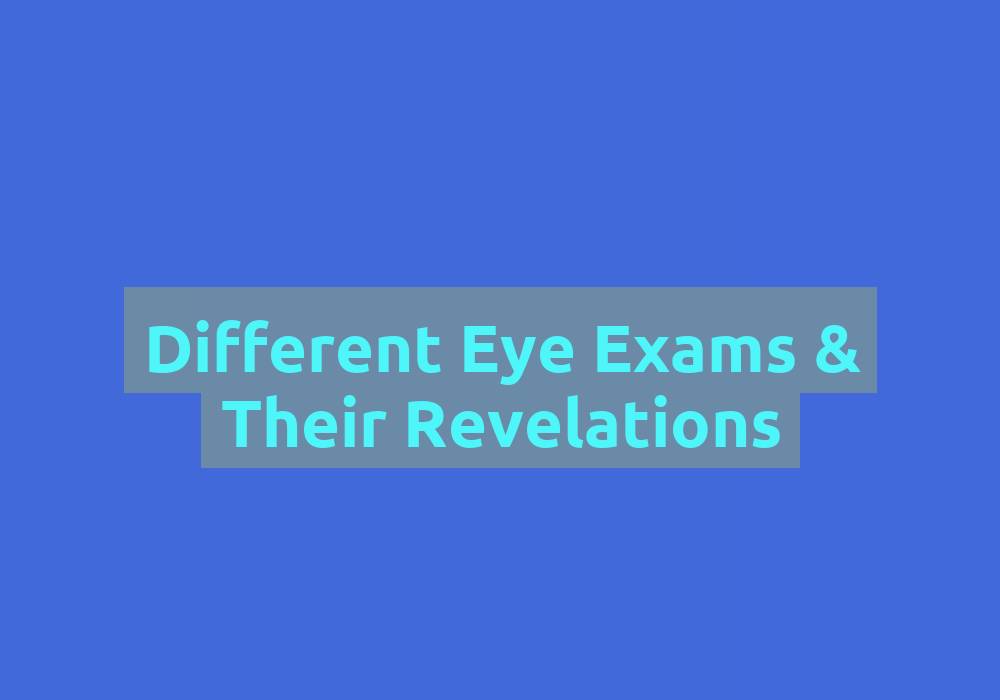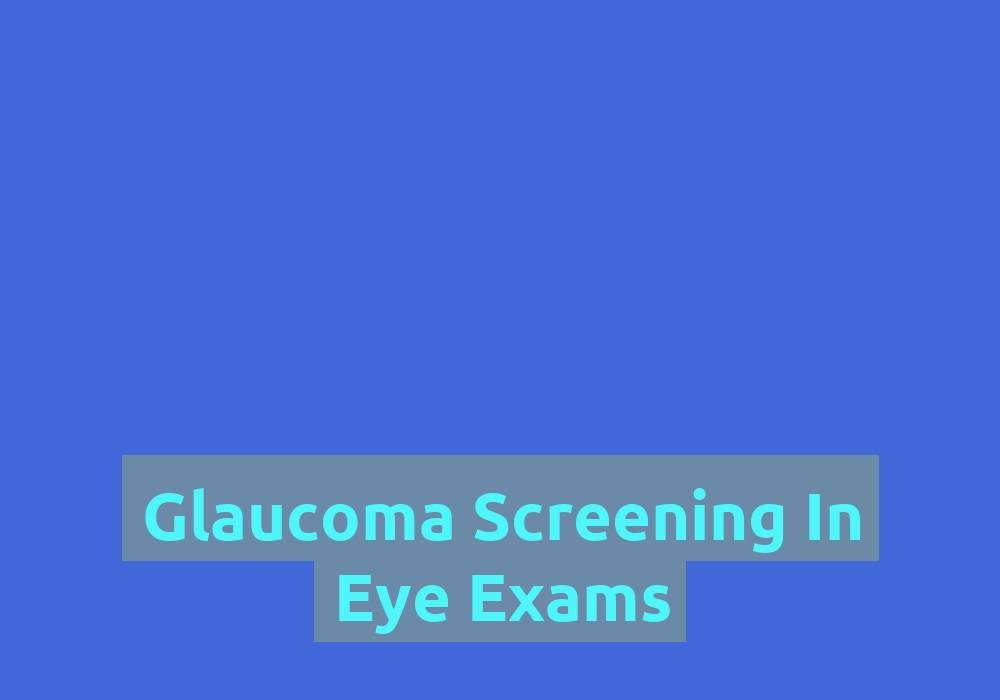Clearing the Fog: The Vital Role of Glaucoma Screening in Eye Exams

Glaucoma, often referred to as the silent thief of sight, is a serious eye condition that affects millions of people worldwide. It is a leading cause of blindness, affecting individuals of all ages. However, with early detection and timely treatment, the progression of glaucoma can be slowed or even halted, preserving vision and improving the quality of life for those affected. In this article, we will explore the vital role of glaucoma screening in eye exams, emphasizing the importance of early detection and comprehensive care.
Understanding Glaucoma: A Sneaky Danger
Glaucoma is an eye disease characterized by damage to the optic nerve, which connects the eye to the brain. This damage is primarily caused by increased intraocular pressure, resulting from a buildup of fluid in the eye. The optic nerve is responsible for transmitting visual information from the retina to the brain, enabling us to see the world around us.
Glaucoma often develops gradually, without noticeable symptoms in the early stages. As a result, many individuals remain unaware of their condition until irreversible damage has occurred, leading to vision loss. This is why regular eye exams, including glaucoma screening, are essential for everyone, regardless of age or visual acuity.
Glaucoma screening is a critical component of comprehensive eye exams as it allows eye care professionals to detect the disease at its earliest stages, even before noticeable symptoms occur. By regularly monitoring intraocular pressure, optic nerve health, and visual field, eye care professionals can identify signs of glaucoma and initiate appropriate treatment promptly.
The Importance of Glaucoma Screening in Eye Exams
-
Early Detection: Early detection of glaucoma is crucial in preventing vision loss. Glaucoma screening plays a vital role in identifying the disease at its earliest stages, even before noticeable symptoms occur. By regularly monitoring intraocular pressure, optic nerve health, and visual field, eye care professionals can detect signs of glaucoma and initiate appropriate treatment promptly. Early intervention can significantly reduce the risk of vision loss associated with glaucoma.
-
Preventing Vision Loss: Timely detection and intervention can significantly reduce the risk of vision loss associated with glaucoma. With proper treatment, the progression of the disease can be slowed or halted, preserving the individual’s remaining vision and preventing further damage. Regular glaucoma screenings ensure that any changes in intraocular pressure, optic nerve health, or visual field are closely monitored, allowing for immediate intervention if necessary.
-
Comprehensive Care: Glaucoma screening is part of a comprehensive eye exam, allowing eye care professionals to evaluate not only for glaucoma but also for other ocular conditions. This holistic approach ensures that all aspects of eye health are addressed, providing a more complete understanding of the patient’s visual well-being. By incorporating glaucoma screening into routine eye exams, eye care professionals can provide comprehensive care and early intervention, leading to better outcomes for patients.
Glaucoma screening involves a series of tests and evaluations that assess various aspects of ocular health. These may include:
-
Tonometry: This test measures the intraocular pressure (IOP) using a device called a tonometer. Elevated IOP is a common sign of glaucoma and can indicate the need for further evaluation. By measuring the IOP, eye care professionals can assess the risk of glaucoma and determine the appropriate course of action.
-
Ophthalmoscopy: Ophthalmoscopy allows eye care professionals to visualize the optic nerve and assess its health. Changes in the appearance of the optic nerve may indicate glaucoma or other optic nerve-related issues. By examining the optic nerve, eye care professionals can detect any abnormalities and determine the presence of glaucoma.
-
Visual Field Testing: This test evaluates the peripheral vision, which is commonly affected in glaucoma. By measuring the sensitivity and range of peripheral vision, eye care professionals can identify any abnormalities that may point to glaucomatous damage. Visual field testing is an essential tool in diagnosing glaucoma and monitoring its progression.
-
Gonioscopy: Gonioscopy provides a detailed examination of the drainage angle within the eye, which is essential for understanding the underlying causes of glaucoma. It helps determine the type and severity of glaucoma and guides treatment decisions. By examining the drainage angle, eye care professionals can gain valuable insights into the condition and develop an appropriate treatment plan.
Glaucoma can affect individuals of all ages, although certain populations are at a higher risk. It is recommended that individuals meet the following criteria should undergo glaucoma screening:
-
Age: Individuals aged 40 and above should have regular glaucoma screenings, as the risk of developing the disease increases with age. Regular screenings can help detect glaucoma early and prevent vision loss.
-
Family History: Individuals with a family history of glaucoma have a higher risk of developing the condition themselves. Regular screening is crucial for early detection and intervention. By identifying individuals with a family history of glaucoma, eye care professionals can closely monitor their ocular health and provide appropriate treatment if necessary.
-
Ethnic Background: Certain ethnic groups, such as African Americans, Hispanics, and Asians, have a higher prevalence of glaucoma and are more susceptible to its adverse effects. Screening is particularly important for individuals from these backgrounds. By understanding the increased risk associated with certain ethnic backgrounds, eye care professionals can tailor their screening protocols and provide targeted care to at-risk individuals.
-
Medical History: Individuals with diabetes, high blood pressure, or a history of eye injuries or surgeries have an increased risk of developing glaucoma. Close monitoring and regular screenings are essential to detect any changes in ocular health and provide appropriate treatment. By considering the medical history of individuals, eye care professionals can identify those at higher risk and ensure they receive the necessary care and attention.
In conclusion, glaucoma screening is an indispensable component of comprehensive eye exams. By detecting glaucoma at its early stages, eye care professionals can provide timely intervention, preserving vision and improving the overall quality of life for patients. Regular screenings are especially important for individuals at higher risk due to age, family history, ethnicity, or underlying medical conditions. Remember, early detection is the key to managing glaucoma effectively and safeguarding your precious gift of sight.
- Why is early detection of glaucoma important?
- Early detection of glaucoma is crucial in preventing vision loss. Glaucoma screening allows eye care professionals to identify the disease at its earliest stages, even before noticeable symptoms occur. By regularly monitoring intraocular pressure, optic nerve health, and visual field, eye care professionals can detect signs of glaucoma and initiate appropriate treatment promptly. Early intervention can significantly reduce the risk of vision loss associated with glaucoma.
- How can glaucoma screenings prevent vision loss?
- Timely detection and intervention can significantly reduce the risk of vision loss associated with glaucoma. With proper treatment, the progression of the disease can be slowed or halted, preserving the individual’s remaining vision and preventing further damage. Regular glaucoma screenings ensure that any changes in intraocular pressure, optic nerve health, or visual field are closely monitored, allowing for immediate intervention if necessary.
- Why is glaucoma screening part of a comprehensive eye exam?
- Glaucoma screening is part of a comprehensive eye exam to evaluate not only for glaucoma but also for other ocular conditions. This holistic approach ensures that all aspects of eye health are addressed, providing a more complete understanding of the patient’s visual well-being. By incorporating glaucoma screening into routine eye exams, eye care professionals can provide comprehensive care and early intervention, leading to better outcomes for patients.
- Who should undergo glaucoma screening?
- Individuals aged 40 and above, individuals with a family history of glaucoma, individuals from certain ethnic backgrounds (such as African Americans, Hispanics, and Asians), and individuals with diabetes, high blood pressure, or a history of eye injuries or surgeries should undergo regular glaucoma screenings. These populations are at a higher risk of developing glaucoma, and early detection is crucial for timely intervention and treatment.

